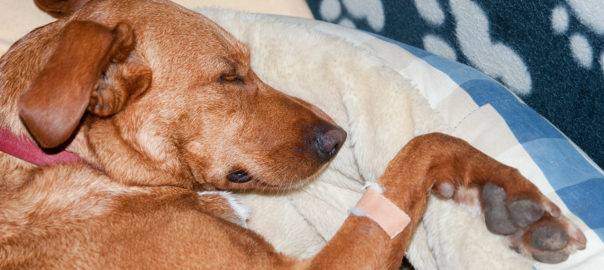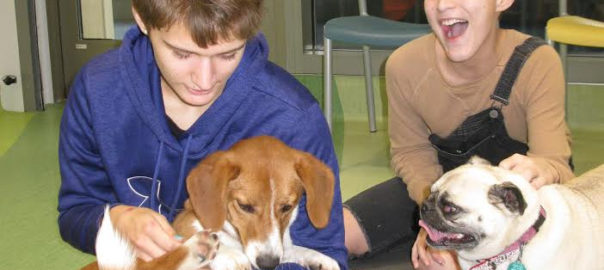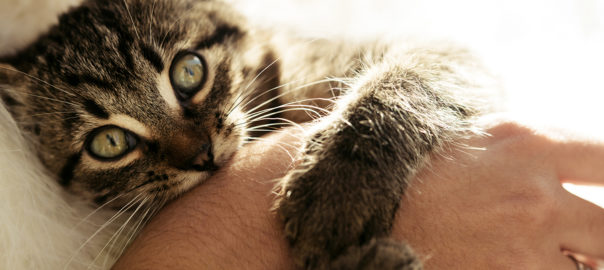Being in the hospital is frightening and stressful for a child. Can you imagine how much easier it would be if their own beloved family pets could come for a visit?
If you ever spent any time in a hospital when you were growing up, or your children or grandchildren have, you know even the shortest stay can be tough. If the child’s condition is serious and the hospital stay is a long one, the stress and anxiety increase exponentially.
We’ve been blessed with nature’s perfect stress relievers in the form of the dogs and cats who live as members of our families. They can lower our blood pressure, boost our immune system, improve depression, anxiety, and fatigue, and shorten recovery time from illness and injury. They’re even associated with lower mortality rates after some serious health crises.
That’s why many hospitals have added pet therapy programs, where specially-trained dogs and other animals visit patients. These are wonderful programs and I believe in them – I’ve been an honorary board member of Pet Partners (formerly the Delta Society) for many years.
But there’s something very special about the bond we have with our own pets. I remember how desperately my own mother, Virginia, longed for a visit from her beloved little dog Sugar Babe during her final hospitalization. And I can only imagine the joy our granddaughter, Reagan, would feel if her dog, or one of Teresa’s and my dogs, was there for her if she ever had to be in the hospital.
Many in the medical field understand that reality very well. One of my team members lost her mother a few years ago, and the hospital allowed her dog to visit her in the hospice unit during her last days.
Nowhere is this a more promising opportunity for healing, however, than in hospitals and units specializing in the care of children.
At the St. Louis Children’s Hospital in St. Louis, Mo., the plight of a young patient named Madison Taliaferro touched the heart of child life services manager Jill Malan. Madison had struggled for her whole childhood with cystic fibrosis. She had to spend long days at home when her friends and schoolmates were sick with minor illnesses that could have been life-threatening to Madison. During those endless days alone, she had one sure source of comfort: her dogs.
Madison finally received a double lung transplant at the hospital. Her parents, grandparents, friends, and hospital staff all gave her love and support during her long, difficult surgery and recovery. But there was one request she remembers making that the hospital wasn’t able to fulfill: “I just wanted to see my dogs,” she said.
“Our doctors see every day the importance of medicine and world class technology,” Malan said. “We see every day the impact a child’s emotional wellbeing has on their overall recovery.”
Malan knew their young patients’ wellbeing would benefit from the opportunity of having what Madison had so longed for: a visit with their own cats and dogs.
As soon as she suggested it, the hospital was on board. Larry Vancil, director of facility services, approached the hospital’s foundation, which reached out to Purina, which is headquartered in St. Louis. The company didn’t hesitate, pledging nearly half a million dollars to support the construction and staffing of a place where hospitalized children could visit with their own pets.
The Purina Family Pet Center opened one year ago, the first in the region and only the fourth such center in the world.
The opening was just what the doctor ordered for two children named Elias and Kristen who had not seen their dogs in the more than two months they’d been in the hospital. This past December, they had the chance to be reunited for quality time together after their dogs made the two-hour journey from their hometown.
“The treatment process is even more challenging when you’re far away from home and separated from family, including four-legged members,” said their mother, Julie Strebe. “Pets bring so much joy to our lives, and having the chance for my children to be comforted by their dogs at the Purina Family Pet Center was a true blessing!”
I’m a veterinarian, not a physician. But I’m also a father and grandfather and a lifelong animal lover. I’m the author of the best-selling book The Healing Power of Pets. I founded Fear Free, dedicated to ensuring animals’ emotional wellbeing is treated as seriously as their physical health.
For all those reasons, I know as surely as I know how to check a pet’s respiratory rate that the presence of a beloved dog or cat is great medicine for children. I hope soon to see centers like this in every hospital that treats children. That day can’t come soon enough!
Disclaimer: While this is not a sponsored post, I am currently working with Purina on a number of educational projects.




